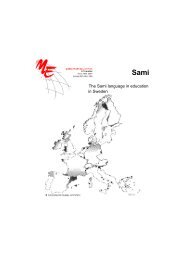Multilingual Early Language Transmission (MELT) - Mercator ...
Multilingual Early Language Transmission (MELT) - Mercator ...
Multilingual Early Language Transmission (MELT) - Mercator ...
You also want an ePaper? Increase the reach of your titles
YUMPU automatically turns print PDFs into web optimized ePapers that Google loves.
status even if the grounds are somewhat different. Both languages are used in teaching, as<br />
tools for meaningful communication.<br />
According to Swain (1981) and Hicky (2001) early immersion programs works the best when<br />
children at home speak the majority, dominant language while they learn the minority<br />
language at pre-school, care centre or kindergarten. The second language is offered in a<br />
playful way, while the high status and social position of dominant home language ensures<br />
that the development of the home language is not interrupted.<br />
In literature definitions of immersion are focused on school settings and not on the preschool<br />
facilities. Some parts of the definitions and descriptions in this section are also<br />
applicable to pre-primary school education. Even though there are no different subjects (like<br />
mathematics, history etc.) offered in pre-school provisions, the are many pre-schools with a<br />
focused didactic curriculum. Pre-school practitioners offer different activities (songs, stories,<br />
games, nursery rhymes, creative activities etc.) in a different form of language as the home<br />
language. Some practitioners have to decide how to deal with the instruction language in<br />
those different activities and which immersion method they want to use. Especially when it<br />
concerns a bi- or multilingual pre-school setting a conscious language choice is important. It<br />
is also important in monolingual settings with multilingual children. The <strong>MELT</strong> project<br />
partners developed a Guide containing examples of linguistic activities and theories, to<br />
increase the skills of practitioners, who are working in a minority pre-school setting with<br />
children from 0 to 4 years. And of course to provide young children with a strong<br />
educational foundation, enabling them to go on and continue to progress with their<br />
multilingual skills.<br />
4.3 Continuous multilingual development<br />
Children who are born in the 21st Century, will grow up as global citizens. The world has<br />
become smaller, children have more knowledge of the world around them. Communication<br />
with people from other cultures with other languages is much easier than ever before. The<br />
awareness about a multilingual upbringing and education is greater than in the 20th<br />
Century. <strong>Multilingual</strong> speaking children are ‘normal,’ due to the increased immigration and<br />
more ‘mixed-cultural’ marriages. Monolingual people are becoming rare exceptions. In the<br />
next sections strategies on how to raise a child multilingual, the importance of the minority<br />
language and the conditions for a continuous multilingual development are described.<br />
4.3.1 <strong>Multilingual</strong> language acquisition strategies<br />
Different researchers show the benefits/ advantages and disadvantages of multilingualism<br />
and there have been studies about the best method to raise a multilingual and multicultural<br />
child. One of the recommendations nowadays is: start as early as possible to educate a child<br />
multilingual. But there are different approaches that allows the child to develop the<br />
consciousness of two or more language systems more quickly than others. Which strategy is<br />
63



